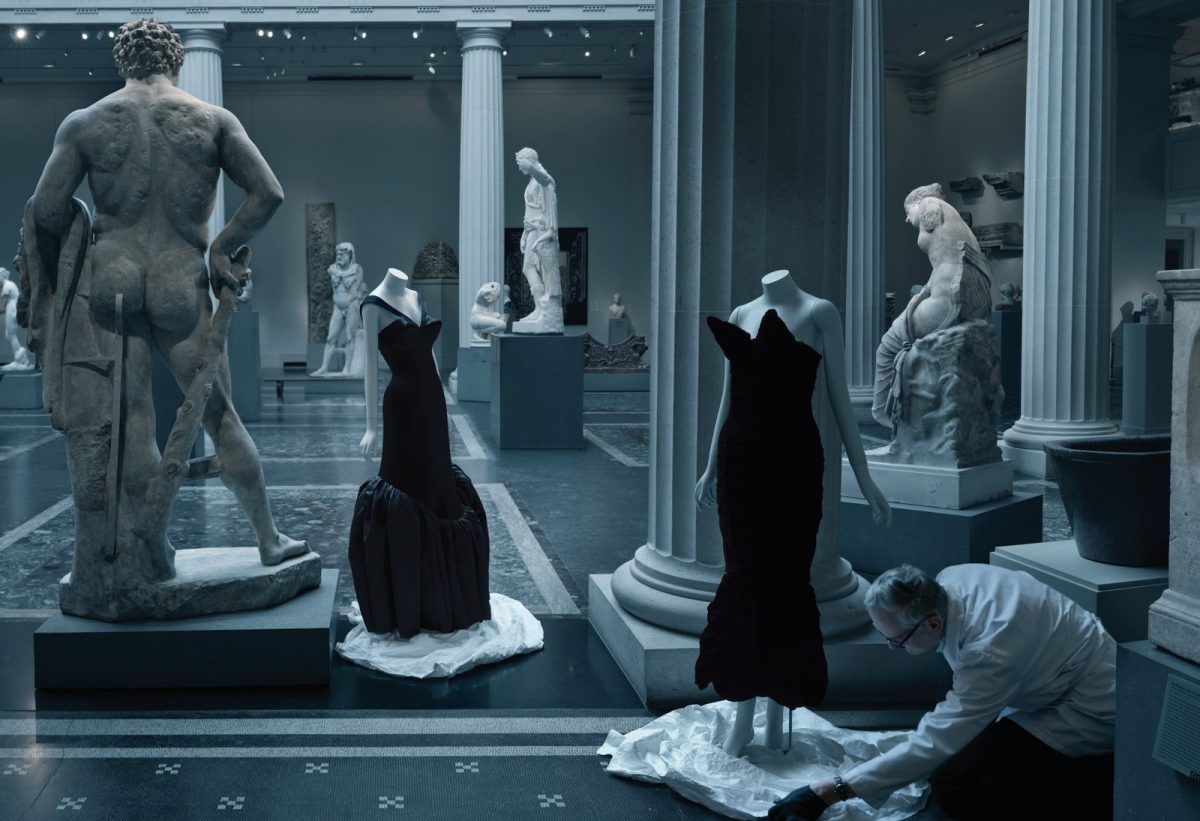As the creative director for Louis Vuitton since 2013, Ghesquière returned to study the Met’s collection of 18th-century menswear, particularly the lavishly embroidered and brocaded vests and court coats. “It’s the most beautiful fashion library,” he says. Ghesquière took that research and reinterpreted some of the pieces for his memorable spring 2018 Vuitton collection, pairing scrupulously reinterpreted shapes and textiles with state-of-the-art trainers. “Nothing is ever like a carbon copy,” Ghesquière explains. “I love the fact that you had this woman that season that was clearly referencing these costume pieces, wearing this 18th–century frock coat, and at the same time was totally in movement, in action, with her sports clothes. I just found it very exciting.” In the exhibition, Bolton has paired a magnificent vest from this Vuitton collection with a sumptuous 1902 French women’s jacket embroidered to evoke a man’s late-18th-century waistcoat—the early-21st and early-20th-century eyes both looking back to prerevolutionary France.
Inspired by the power of artist Kara Walker’s disquieting silhouettes, Bolton has focused on garments that are essentially either black or white, complicating the selection process exponentially but amplifying the visual drama in equal measure. “What’s really fascinating to me—and what I’ve learned by spending time with Andrew and his department,” Devlin explains, “is that this exhibition is really 120 female bodies. We’re showing a kind of etymology of the architecture of the female form and all that that implies.” Devlin mentions the “emotional impact” of seeing the 19th-century pieces with their pinched-in waists and cumbersome bustles. “When I was studying theater design, we studied the history of architecture in parallel with the history of costume and the history of dress,” Devlin recalls. “It’s a really fun study to make: What happened when the corset vanished? In each inch that comes in and out of a sleeve or a waist or a butt or a hip, there’s so much implied about social, political, and cultural history.”
The exhibition’s handsome catalog is threaded with literary musings on the nature of time, largely taken from early-20th-century writers, including T. S. Eliot and Virginia Woolf, who were so engaged with the subject. Woolf’s time-traveling, gender-fluid hero/heroine Orlando might be the muse of the exhibition. “For what more terrifying revelation can there be than that it is the present moment?” writes Woolf in her 1928 novel of the same name. “That we survive the shock at all is only possible because the past shelters us on one side, the future on another.” Michael Cunningham, whose Pulitzer Prize–winning 1998 novel The Hours drew inspiration from Woolf’s Mrs. Dalloway, has written a short story, “Out of Time”, that considers a day in the life of one Odessa Bonthrop, beginning in the early morning of 1870 and ending 24 hours later in 2020.
It was director Sally Potter’s 1992 movie adaptation of Orlando, starring a suitably androgynous Tilda Swinton, that first fueled Bolton and Devlin’s ideas for staging the exhibition—particularly a beautiful scene that sees Swinton’s Orlando (costumed by Sandy Powell) enter a garden maze in mid-18th-century court costume and high powdered wig and leave it as a Victorian woman in the dress and hairstyle of a century later. An initial mazelike exhibition layout has now ceded to two rooms that evoke the idea of clocks—one of dark wood, “almost like the inside of a grandfather clock,” as Devlin explains, and the other of mirrors, “rather like walking into a Yayoi Kusama piece. Everything about your anatomy feels different when you’re in an enclosed, dark, wooden, completely hushed space as opposed to being in a vast, mirrored, expansive, reflective, fragmented one,” Devlin adds, “so it’s really an expression of how time felt—and how time now feels, because we all have a different relationship to time now than we would have in 1870.” The clock echoes the drama of Foucault’s pendulum of 1851, designed to illustrate the movement of the Earth and installed at the Panthéon in Paris, which Ghesquière showed Devlin.
The exhibition ends with a coda that will explore Bolton’s own take on fashion now—“whether it’s about sustainability or traceability, the ethics of fashion, or even the idea of looking back in time,” he says—and focusing on examples that “advocate for a slowing down of fashion and a reemphasis on the values inherent in its creation.” For him, these pieces include Demna Gvasalia’s dramatic revisiting of Cristóbal Balenciaga’s 1939 Infanta silhouette and Marine Serre’s stylish upcycling of deadstock tweed used with flea-market jewelry (“a combination of a Schiaparelli and a Chanel,” says Bolton, “and a wonderful conflation of two designers who were always at odds with each other—she reconciled them!”).
“I think it’s a quest of any designer to look for . . . I will not say ‘eternity,’ but a certain longevity in your work,” says Ghesquière, citing his pride in the value placed on his vintage Balenciaga pieces now. “It’s fashion, and it’s great to witness our time and to say, ‘This is what I feel for now, for exactly now, at this moment,’ but when your clothes live longer—when your style lives longer—I think that’s the best thing.”

